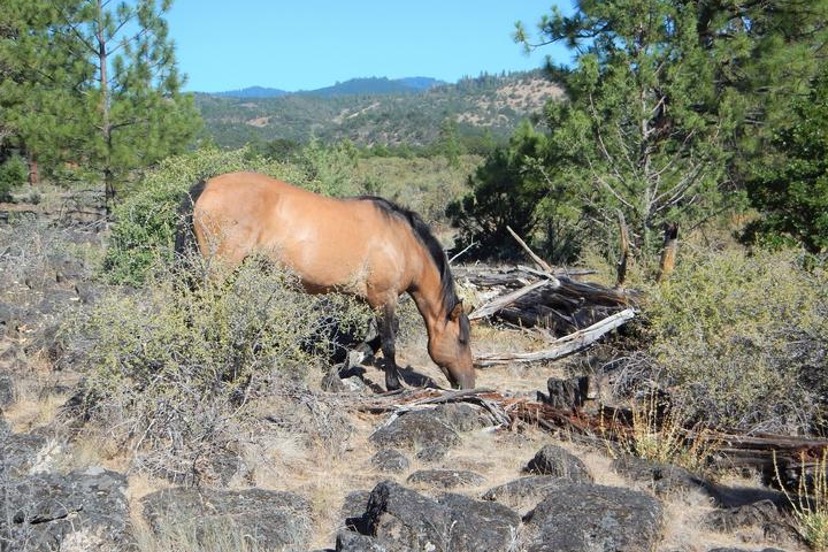PHOTO: A wild horse (an Iberian mare) is seen reducing grass and brush in the rugged, remote area of the Cascade Siskiyou National Monument along the Oregon-California border. Photo: William Simpson
A 6-year old Western Journal article cites the problem that has since grown significantly worse and is facing many Americans today.
People and organizations who are financially benefiting from — and making millions of dollars by monetizing — wildfires have a serious conflict of interest and should be disallowed from participating in wildfire-solution forums and committees. These people and entities should also be barred from influencing legislators.
These are desperate times, and we need genuine solutions, not influences driving wildfire profiteering.
Extremism is not in the best interest of our very survival. The U.S Forest Service and Bureau of Land Management are not engaged in Wildfire Prevention, nor in getting them immediately controlled.
It’s a plain fact that the evolution of catastrophic abnormal wildfires are the result of our collapsed herbivory.
One of many published peer-reviewed studies on the collapse of our herbivory and resulting evolution of catastrophic wildfire is titled, Collapse of the world’s largest herbivores
An excerpt from that study states:
By altering the quantity and distribution of fuel supplies, large herbivores can shape the frequency, intensity, and spatial distribution of fires across a landscape. There are even unique interactions among large herbivore populations that can influence fire regimes. For example, facilitative interactions between white rhinoceros and mesoherbivores result in reduced fuel loads and fuel continuity, and consequently fewer large, intense fires.
Numerous scientific studies report that when the population of native gazers collapses, it results in millions of tons of un-grazed grass and brush (1-hour class fuels). Oregon’s deer population is down about 500,000 animals over the past 20-years and California’s deer population is down at least 2 million deer over the past few decades. These missing native grazers were abating about 3.5 million tons of annual grass and brush per year. Each blacktail deer consumes about 1.3-tons of grass and brush per year, and each mule deer (2.2 tons/yr.), while elk (3.6-tons/yr.) consume more.
Most of the un-grazed grass and brush exist in our rugged-remote wilderness areas that are unsuited for livestock wildfire grazing due to difficult transportation logistics and depredation of commercial livestock by apex predators, both of which adversely impact profits.
Instead of doing what’s logical and effective, these government agencies are arguably managing deadly wildfires as controlled-burns for weeks and months as a new model to monetize the forests that are no longer being logged, and could be logged using the newest enlightened and environmentally friendly methods.
Instead of managing wildfire as controlled burns and sending millions of tons of particulates and deadly carbon compounds into our atmosphere (and our lungs) — and promoting climate change — we could replace those jobs with new ones in a modernized timber industry.
And by reestablishing the herbivory in remote wilderness using excess (relocated-rewilded) American wild horses, we can cost-effectively, as science and empirical experience prove, reduce the frequency, size and intensity of wildfires and resulting toxic smoke. Each wild horse deployed into a wildfire fuels management role removes about 5.5 tons of grass and brush per year. This action provides taxpayers with about $72,000.00 in value for each wild horse deployed.
Instead, wildfires have become of new source of Federal Income sourced from terrified taxpayers (soft extortion?) whose taxes now fund the monetization of wildfire and the destruction of our forests and wildlife.
Wildland firefighters are also getting shafted. They are fodder for this insane, ecologically-environmentally reckless wildfire industry. Firefighters are not being fully informed about the significantly reduced life expectancy that results from inhaling wildfire smoke.
This article doesn’t come close to how bad it really is. For further reading: https://wildfiretoday.com/2021/06/11/a-brief-look-wildland-firefighter-smoke-exposure-and-risk-of-lung-and-cardiovascular-disease/
William E. Simpson II is a naturalist, author, and conservationist living in the Soda Mountain wilderness area among the wild horses that he studies. Learn more at Wild Horse Fire Brigade.

